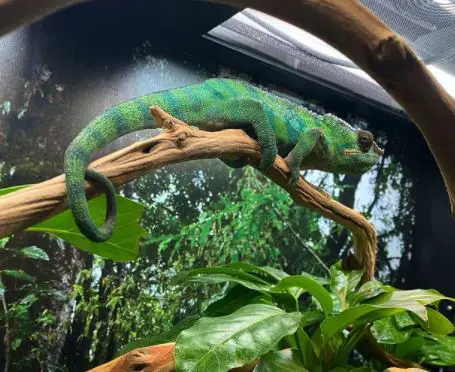Do you want to decorate a chameleon cage but don’t know how?
The best way to decorate a chameleon cage is to start with the basics. Once you’ve got the essentials down, you can add in some colorful accents that will make your pet feel right at home.
A few things that every chameleon needs are shelter from the sun and rain, a place for its food and water dish, and somewhere to hide when it feels threatened.
If your pet also likes climbing on branches and rocks as most other reptiles do, try adding those, too!
Related Posts:
- Top 8 Best Misting System for Chameleons
- How to Keep a Chameleon Cage Warm?
- How to Clean the Bottom of a Chameleon Cage?
- What Plants to Put in a Chameleon Cage?
- How to Raise Humidity in a Chameleon Cage?
How to Decorate a Chameleon Cage?
So, how to decorate a chameleon cage?
There are too many types of chameleon cages available on the market. You can buy a nice one for your pet and decorate it with some accessories. Chameleons like hiding, so you need to provide them with such places.
They also like climbing, so you should put some perches in their cage.
Materials:
- Branches
- 4 plastic bottles for water
- 2 or 3 pieces of different size rocks
- Moss, soil, and stones (optional)
- Rope (optional).
Instructions:
- We choose branches. Make sure that there is no paint on them as chameleons don’t like it.
- Some pieces of the branch should be laid on the bottom of the cage.
- We continue to put some rocks inside. The more, the better!
- Cover them with moss, which is a humidity provider. Or you can use soil directly.
- Connect two branches and make a hole in one of them.
- Put the plastic bottles.
- Place the tree bark anywhere you want.
- If you think there aren’t enough hiding places (which I doubt), you can make a hole in some other pieces of tree bark and put it inside.
- Your chameleon’s house is ready!
If you want, you can add a little piece of rope to the top.
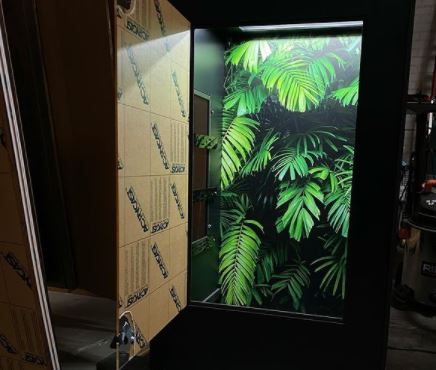
How to Set Up the Perfect Veiled Chameleon Cage?
Now that you get an idea of how to decorate a chameleon cage, let us find out the perfect setup for your veiled chameleon habitat.
We will look at tank size, lighting and heat requirements, suitable substrate types, and how much time should be invested in the setup of the cage.
If you are new to keeping chameleons or if you just want to get it right from the beginning, then this is definitely an article worth reading.
1. Tank Size and Shape
One of the most common mistakes made when setting up a veiled chameleon cage for the first time is that people tend to underestimate how large it needs to be.
A normal 20-gallon-long aquarium can be classified as too small simply because veiled chameleons grow that large only in captivity!
For the first 6 months, the veiled chameleon will grow about 15% in body size, so if your veiled chameleon is a juvenile of 4 inches, it will only be 5.4 inches after a year.
Be aware that a normal adult veiled chameleon can easily reach an arm span of 70 centimeters while being only 20 to 30 centimeters from head to tail!
From my experience, it is clear that while 40-gallon-long tanks are definitely the best choice for adults, I would recommend setting up a 30 x 30 x 60-inch Exo Terra or ZooMed tank for juveniles and adults of smaller sizes.
The reason is simply that these tanks have been proven over time to provide excellent ventilation and can fit more percolation material within its frame (which will make your chameleon feel more at home and less stressed).
Just keep an eye out for how high the tank is once all materials are added to it.
Remember that if you buy a tall tank like the Exo Terra 60 x 30-inch tall tank, then you need to add 15cm (6 inches) of the substrate.
This is because veiled chameleons prefer having a taller area within their cage where they can climb up without help from you.
Thus, when buying such tall tanks, don’t forget to plan accordingly by adding about 15 extra centimeters of height in there so the chameleon has room to move up above its basking spot!
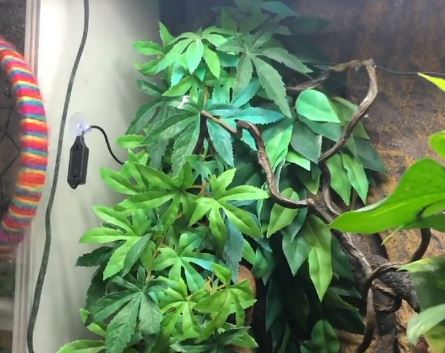
Chameleons need space. They are animals that require room to move around just like us.
When you purchase a cage for your pet, keep in mind where you will be putting it and how big it will need to be. Also, keep in mind that your pet will continue to grow. You should be prepared for this.
2. Substrate
The perfect veiled chameleon substrate is simply made up of different elements, which provide humidity, warmth, and protection.
The most common substrates used for this type of cage are sphagnum moss, coco coir, or plain old soil.
If you keep your chameleon in a tall tank, then I generally recommend using 2 to 3 inches of substrate (which also means that you will be able to fit in with more percolation material).
If you choose to use the nicer-looking coconut fiber, then remember not to use any additives like calcium because it might cause problems when the chameleon digs around in the substrate.
You should also avoid vermiculite as well since its texture can cause impaction if consumed!
Soil is by far one of the most popular veiled chameleon substrates out there.
This is because it provides great moisture while still looking nice.
To give your chameleons the best possible chance of surviving, you should really mix in 10 to 15% organic topsoil with your existing soil to make sure it has all the nutrients and minerals needed for your veiled chameleon to thrive!
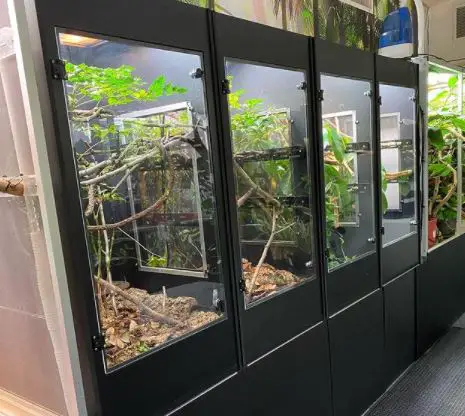
3. Heat Requirements
To ensure good health, veiled chameleons need temperatures above 75 degrees Fahrenheit (24 degrees Celsius) during the day, dropping down into the low 70s at night. You can allow their basking spot to reach up to 90 degrees Fahrenheit (32 degrees Celsius).
However, don’t forget that this needs to be combined with a warm gradient further down so that your chameleon can regulate its body temperature by moving about.
The perfect way to achieve the right gradient is by using a heat mat combined with an infrared/ultraviolet lamp above it (at least 10 inches away though).
You can also opt for placing dimmer switches on your basking light so that you can adjust not just the height of it but also its strength.
Remember that these lights need to be replaced every year or two since they tend to lose their full spectrum over time! Alternatively, there are, nowadays, special T5 UVB/UVA bulbs available that don’t cost much and provide good lighting for your veiled chameleons.
Make sure they are roughly 12 to 18 inches above the surface, though, since even if they emit the right UV rays, they might not let your chameleon bask properly in them!
Now, when it comes to heating the cage itself, I suggest using heat mats, which you place underneath one side of the tank (in order for your veiled chameleon to decide where it wants its basking spot to be).
These heat mats should cover about 1/3 of the length and height of the tank so that your chameleon can move around freely without being too hot.
Also, make sure that there are no sharp rocks placed under these heat pads since they will get extremely hot during use and thus burn holes into the bottom of your tank!
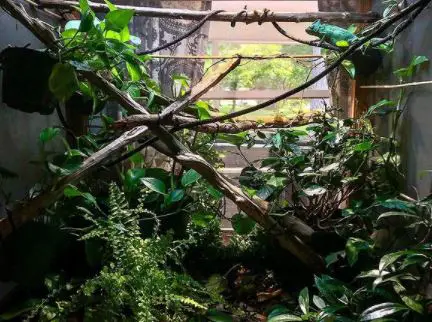
4. Water Requirements
Plenty of good water should always be present within a veiled chameleon’s habitat. A drip system can easily be set up to ensure that it always has a steady supply of water available.
Remember that birds and other desert animals usually get most of their water from the food they eat so you should aim for your veiled chameleon to get at least 70% of its water from misting and spraying!
A cool place should be provided within the tank so that your chameleon can retreat if things get too hot.
This shaded area can consist of various containers, which hold damp moss, sphagnum, or even moist paper towels.
Just remember not to use these sponges since they might cause impaction if consumed by mistake!
If the room doesn’t allow for such a spot, then try using a wide, flat plant leaf and mist it every day. This way, your veiled chameleon will always have a place to retreat and can drink water from the leaf itself!
5. Hiding Requirements
Veiled chameleons need places where they can hide and feel safe.
You should provide one or two hides at opposite ends of the cage so that they can choose which side suits them best (remember that each veiled chameleon has its own personality just like humans do).
These hides can either be purchased as premade plastic hides online or, alternatively, you could use paper towel rolls/toilet paper rolls for this purpose instead.
6. Food Requirements
Since veiled chameleons are omnivorous animals, you will need to feed them a good variety of food items in order to ensure good health.
These might include grasshoppers, crickets, silkworms, fruit flies, and even small slugs from time to time. Make sure that their diet is supplemented with good quality chameleon pellets, which contain all the right nutritional value for your veiled chameleon.
Leafy greens can also be given as a part of a varied menu but should not consist of more than 50% of the total diet since they can’t provide any real nourishment for your chameleon by themselves!
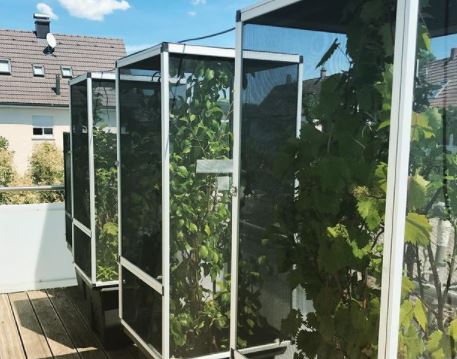
7. Housing Requirements
It’s generally better for a veiled chameleons’ cage to be taller rather than wider since these lizards prefer climbing around as opposed to walking on the ground (granted they have the height).
A full-grown adult veiled chameleon can have a cage as tall as 4 feet, so it needs to be kept in an appropriately sized enclosure.
A single chameleon will need a minimum of a 30-gallon tank since these animals grow quite large and they spend most of their time on tree branches or plant leaves during the day!
What to Do When Your Chameleon Cage Smells?
How often does your chameleon’s cage need to be cleaned?
Like many other reptiles, a chameleon’s enclosure should be spot cleaned as needed. This means if there is feces or uneaten food in the enclosure, it should be removed as soon as possible.
Depending on the size of your terrarium and how often you feed your chameleon, this may require cleaning every day.
If you only feed your pet once a week, then you should probably clean out their home at least once a week.

If your chameleon’s tank is not cleaned on a regular basis, the smell of their waste can become quite strong and even dangerous to your pet.
Dirty cages can lead to respiratory infections in reptiles like chameleons, which make it hard for them to breathe, making them more susceptible to diseases and other problems.
It is also important to remember that if you see any injuries or signs of illness, seek veterinary care immediately!
Conclusion
Keep in mind that you will need to purchase a UV light, water dish, and food bowl. You should also provide hiding places for your chameleon with live or fake plants.
The size of the cage is important as well. Make sure it’s big enough for your pet to feel comfortable without feeling cramped.
And take the time to decorate the chameleon cage so that your pet enjoys their time in it!
Finally, remember to change the substrate (ground) every few days so there are no odors left over from old droppings!
Key points for how to decorate a chameleons cage:
Decorating your chameleon’s cage is not just about aesthetics; it’s about creating an environment that supports their well-being. Chameleons have specific needs, and their habitat should cater to those requirements. Here are some valuable tips for decorating a chameleon’s cage:
1. Research Chameleon Species:
- Different chameleon species have varying habitat preferences. Ensure you know the specific requirements of your chameleon’s species before decorating.
2. Adequate Enclosure Size:
- Select an enclosure that provides ample space for your chameleon to move, climb, and thermoregulate. A larger enclosure is often better.
3. Cage Orientation:
- Place the cage in an area with proper lighting but avoid direct sunlight, which can overheat the enclosure. Consider proper ventilation and airflow.
4. Substrate Selection:
- Chameleons typically do not require a substrate, but if used, choose something that is non-toxic, clean, and easy to replace, such as paper towels or reptile carpet.
5. Climbing Opportunities:
- Chameleons are arboreal and love to climb. Provide branches, vines, and perches of varying heights to mimic their natural environment.
6. Live Plants:
- Live plants can enhance the enclosure’s aesthetics and provide a more natural habitat. Select non-toxic, chameleon-safe plants like hibiscus or ficus.
7. Foliage for Privacy:
- Chameleons may become stressed if they are constantly exposed. Use artificial or live plants to create hiding spots for privacy and security.
8. Dietary and Hydration Stations:
- Place designated feeding and hydration stations, such as cups or bowls, in easily accessible locations to prevent contamination of the entire enclosure.
9. Humidity Control:
- Chameleons require proper humidity levels. Incorporate a hygrometer and misting system to maintain adequate humidity. Live plants can also help.
10. UVB Lighting: – Ensure the proper positioning of UVB lighting to provide adequate exposure to your chameleon. Research the specific needs of your chameleon species.
11. Basking Area: – Create a basking spot with a heat lamp to establish a temperature gradient. Chameleons need access to warm and cooler areas.
12. Natural Elements: – Incorporate natural elements like rocks, twigs, or driftwood to add diversity to the enclosure and provide additional climbing opportunities.
13. Habitat Maintenance: – Regularly clean and maintain the enclosure to prevent the build-up of waste, mold, and bacteria. Maintain proper hygiene for your chameleon’s health.
14. Avoid Overcrowding: – While decorating, avoid overcrowding the enclosure. Chameleons need room to move, and clutter can lead to stress.
15. Temperature Monitoring: – Use a thermometer to monitor temperature levels and make any necessary adjustments to ensure your chameleon’s comfort.
16. Environmental Enrichment: – Stimulate your chameleon’s mind with items like hanging plants or objects for exploration and mental engagement.
17. Observation: – Spend time observing your chameleon’s behavior to make adjustments as needed. Chameleons may display preferences for certain areas or hiding spots.
In summary, decorating a chameleon’s cage should prioritize their physical and psychological needs. By creating a well-planned, species-specific habitat with climbing structures, live plants, proper lighting, and a focus on hygiene, you can ensure a happy and healthy environment for your chameleon. Regularly monitor and maintain the enclosure to provide the best possible care for your unique reptile companion.
Further Reading:
- Best Lighting for Chameleons: What Is the Best Bulb?
- Best Plants for Turtle Tank
- Bearded Dragon vs. Chameleon: Facts and Differences
- What Kind of UVB Bulb for Chameleon?

